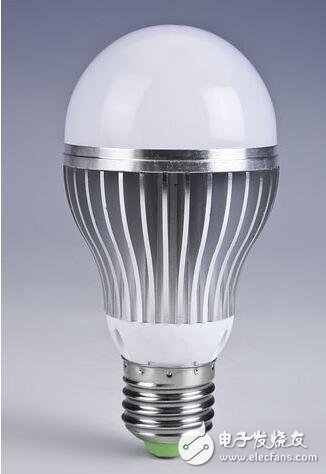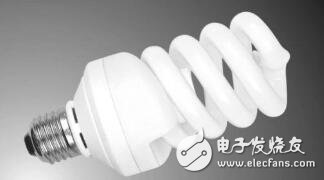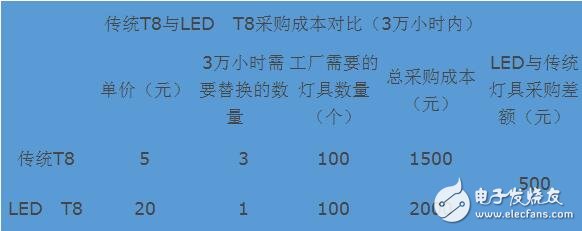LED lights, LEDs are referred to as LEDs. A diode made of a compound containing gallium (Ga), arsenic (As), phosphorus (P), nitrogen (N) or the like can emit visible light when electrons and holes are combined, and thus can be used to form a light emitting diode. Used as an indicator light in circuits and instruments, or as a text or digital display. The gallium arsenide diode emits red light, the gallium phosphide diode emits green light, the silicon carbide diode emits yellow light, and the gallium nitride diode emits blue light. Organic light-emitting diodes OLED and inorganic light-emitting diode LEDs are further classified by chemical properties.
What are the advantages of LED lights:
1, energy saving, white LED energy consumption is only 1/10 of incandescent lamps, 1/4 of energy-saving lamps.
2, longevity, life expectancy of up to 100,000 hours, for ordinary home lighting can be described as "once and for all"
3, can work in high speed state. If the energy-saving lamp starts or turns off the filament frequently, it will turn black and quickly break.
LED shortcomings: high starting cost, poor color rendering, low efficiency of high power LED, constant current drive (requires dedicated drive circuit). In contrast, various traditional lighting has certain drawbacks.

Energy-saving lamps, also known as power-saving bulbs, electronic bulbs, compact fluorescent lamps, and integrated fluorescent lamps, are lighting devices that combine fluorescent lamps with ballasts (ballasts). In 2008, the state launched the “Green Lighting†project, and urban and rural residents and enterprises enjoyed a certain proportion of subsidies for the use of energy-saving lamps for successful bidders. The promotion of energy-saving lamps is of great significance. However, the environmental hazards of used energy-saving lamps have also attracted attention. By the end of October 2012, hundreds of millions of energy-saving lamps were scrapped for energy-saving promotion projects, each of which could contaminate 180 tons of water and soil, and the disposal and recycling of used energy-saving lamps caused concern. Despite this, the demand for energy-saving lamps is still growing, especially in the just-present 2014, demand is still increasing.
What are the advantages of energy saving lamps:
1. Compact structure and small size.
2. The luminous efficiency is high at 60Lm/w, and the power saving is over 80%, saving energy.
3, can directly replace incandescent bulbs.
4, long life, 6 to 10 times the incandescent lamp.
5. The inner wall of the tube is coated with a protective film and the triple spiral filament can greatly extend the service life.
What are the disadvantages of energy-saving lamps :
1. There is mercury pollution in the production process and after use. At present, Western countries pay considerable attention to mercury pollution. Chinese people are also increasingly aware of the dangers of mercury pollution.
2, because it is a glass product, easy to break, not good transportation, not easy to install
3, its power consumption is still too big
4, easy to damage, short life, energy saving does not save money, this sentence is its best portrayal.
What is the difference between led and energy saving lamps?The energy-saving lamp is the abbreviation of CFL (Compact Fluorescent Lamp), which is mainly energy-saving compared with the original incandescent lamp.
LED bulb refers to the bulb that uses LED as the light source. Its light efficiency is also high. It is a new type of bulb, which has a tendency to replace CFL. In recent years, some lighting exhibitions are also basic LED lamps.
At present, the CFL is slightly lower than the CFL, and the CFL generally has a luminous efficacy of 50-65 lm/W. The LED itself has a very high luminous efficiency, and most of it is currently between 100-130 lm/W. However, due to the illumination angle of the LED, etc., the light effect of the whole lamp is about 65-80 lm/W, and the difference between the two is not too large. However, the price of CFL and LED with the same luminous flux is generally about 2-4 times, the difference between small power and small price is small, and the difference in power is relatively large. The life between the two is slightly higher than that of energy-saving lamps. The nominal life is 6000-12000h, and the nominal life of LEDs is 10000-20000h. These comparisons are only for comparisons with some exports to the EU or North America. Due to the uneven quality of sales in the country, detailed assessments cannot be made. But the best life expectancy is the general order of export orders in these regions (including the so-called international brands philips, osram, etc.).
For the problem of visual damage, the incandescent bulb is better than the CFL, and the CFL is better than the LED. In particular, most of the LED whole lamps currently sold in LEDs do not pay attention to the influence of LED on vision, and deliberately reduce the loss of light efficiency between the LED light source and the whole lamp, so that the whole lamp has higher light efficiency. Luminous flux and other data, using a single-stage PFC line (has higher ripple, easy eye fatigue), to meet China's first-class standards for lamps, the price requirements of the end.

First of all, it must be emphasized that LED bulbs are more energy efficient than energy-saving lamps. This is what most people know, or have heard of, but many people still have doubts about this. After all, it is not counted where this electricity is saved. .
Due to the difference between the principle of energy-saving lamps and LED lighting, their luminous efficiency is different. The luminous efficiency of halogen powder energy-saving lamps is only 30-40 lm/W. The luminous efficiency of three-color energy-saving lamps will be higher than that of halogen powder energy-saving lamps. -60lm/W (different brands of products, different quality, different luminous efficiency, Philips energy-saving lighting effect of about 60lm / W). However, the luminous efficiency of LEDs is much higher than that of energy-saving lamps, and the current technical level has generally reached 90-100 lm/W. Therefore, in essence, the brightness of 1W LED requires at least about 2W of energy-saving lamps to achieve the same brightness, but the actual perceived brightness is also affected by many factors. The most direct factor is temperature, high temperature will produce Light decay, energy-saving lamps will produce bright heat, and LED is a cold light source, the heat generated is much smaller than energy-saving lamps, so LED light decay is smaller than energy-saving lamps;
There are still many buyers, users know that LEDs are more energy efficient than energy-saving lamps, but they think that LED prices are more expensive than energy-saving lamps. The savings in electricity costs are not enough to make up for the part of the money spent on buying lights, so it is decided to continue to buy relatively cheap. The use of energy saving lamps. The following table is a comparative analysis of the cost of using LEDs and energy-saving lamps. Take the T8 tube as an example.
Tip: (LED life 2500 hours - 30,000 hours; energy-saving lamp life is 5000 hours), the following is the comparison of procurement costs and electricity costs within 30,000 hours).


As can be seen from the above table, the amount of electricity that is spent in the process of using energy-saving lamps far exceeds the amount saved when purchasing energy-saving lamps. Moreover, the electricity price of the example in the table is only 0.5 yuan, the working time is 8 hours, and the number is 100. Now the household electricity is using the stepped charging mode, and the unit price of industrial electricity is much higher than this, and the enterprise The number of lighting fixtures required is also far more than 100. The working hours in the factory floor are not only 8 hours, which means that the actual electricity bill is far more than just RMB 31,500. Therefore, it is recommended that you try to use LED lamps, especially for enterprise users who use a lot of them, but it is best to choose a first-line brand for LED lamps, which is produced by powerful manufacturers.
We supply China 2022 Newest Rechargeable Vape 5000 Puffs Mesh Coil Disposable Wholesale Disposable Vape Pen, Find details about China 5000 Puffs Vape from 2022 Newest Rechargeable Vape.
Fair price and high quality products. we sell many well-known brand products. You can definitely find what you want in tsvping.com.e are a vape (ecigarette) factory located in China.
Wholesale Supply OEM/ODM 5000 Puffs Disposable Vape Pod Device.
Vape 5000 Puffs,Disposable Vape 5000 Puffs,E Cigarette Juice,E Cigarette Liquid
TSVAPE Wholesale/OEM/ODM , https://www.tsecigarette.com